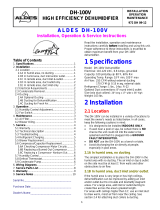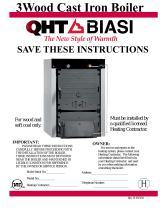
L-2516 ENGLISH
Table of Contents
INTRODUCTION . . . . . . . . . . . . . . . . . . . . . . . . . . . . . . . 1
R
EAD THIS MANUAL BEFORE PROCEEDING . . . . . . . . . 1
CONTROLS OVERVIEW . . . . . . . . . . . . . . . . . . . . . . . . 1
F
EATURES . . . . . . . . . . . . . . . . . . . . . . . . . . . . . . . . . 1
H
OW IT WORKS . . . . . . . . . . . . . . . . . . . . . . . . . . . . . 1
The Importance of Seawater Temperature . . . . 1
Power Interruptions . . . . . . . . . . . . . . . . . . . . . . 2
D
ESCRIPTION OF THE CONTROLS . . . . . . . . . . . . . . . . 3
I
MPORTANT PROGRAMMING NOTES TO INSTALLER AND
END USER . . . . . . . . . . . . . . . . . . . . . . . . . . . . . . . . . 4
N
ORMAL HEATING OR COOLING CYCLE . . . . . . . . . . . . 5
R
EVERSING VALVE OPERATION . . . . . . . . . . . . . . . . . 5
INSTALLING THE DISPLAY PANEL . . . . . . . . . . . . . . . 5
M
OUNTING THE DISPLAY . . . . . . . . . . . . . . . . . . . . . . 5
M
OUNTING THE SENSORS . . . . . . . . . . . . . . . . . . . . . . 5
Ambient Temperature Sensor - required . . . . . 5
Seawater Temperature Sensor - optional . . . . . 5
Outside Air Temperature Sensor - optional . . . 6
Humidity Sensor - optional . . . . . . . . . . . . . . . . 6
OPERATION . . . . . . . . . . . . . . . . . . . . . . . . . . . . . . . . . . 6
O
PERATOR CONTROLS AND DISPLAY PANEL . . . . . . . . 6
Button Functions . . . . . . . . . . . . . . . . . . . . . . . . 6
M
ODES OF OPERATION . . . . . . . . . . . . . . . . . . . . . . . 6
Power On and Basic Modes . . . . . . . . . . . . . . . 6
Dehumidification Mode . . . . . . . . . . . . . . . . . . . 7
Adjusting the Set Point . . . . . . . . . . . . . . . . . . . 7
Fan Operation and Control . . . . . . . . . . . . . . . . 7
Memory . . . . . . . . . . . . . . . . . . . . . . . . . . . . . . . 7
Display Inside Cabin Temperature . . . . . . . . . . 7
Dimming the Display . . . . . . . . . . . . . . . . . . . . . 7
Sleep Mode . . . . . . . . . . . . . . . . . . . . . . . . . . . . 7
Lockout Display Mode . . . . . . . . . . . . . . . . . . . 7
Anti-Ice Routine . . . . . . . . . . . . . . . . . . . . . . . . 8
PROGRAMMING THE CONTROL . . . . . . . . . . . . . . . . . 8
P
ROGRAMMING PROCEDURE . . . . . . . . . . . . . . . . . . . . 8
P
ROGRAMMABLE FUNCTIONS . . . . . . . . . . . . . . . . . . . 8
Customizing the Functions . . . . . . . . . . . . . . . . 8
Restoring Factory Default Settings . . . . . . . . . . 8
Description of Functions . . . . . . . . . . . . . . . . . . 8
Summary Table of Programmable Functions . 14
FAULT AND ERROR MESSAGES . . . . . . . . . . . . . . . . 15
H
IGH-PRESSURE SHUTDOWN (HI / PS) . . . . . . . . . . . 15
In Cool Mode . . . . . . . . . . . . . . . . . . . . . . . . . . 15
In Heat Mode . . . . . . . . . . . . . . . . . . . . . . . . . . 15
L
OW-PRESSURE SHUTDOWN (LO / PS) . . . . . . . . . . . 15
In Cool Mode . . . . . . . . . . . . . . . . . . . . . . . . . . 15
In Heat Mode . . . . . . . . . . . . . . . . . . . . . . . . . . 15
L
OW-VOLTAGE SHUTDOWN (LO / AC) . . . . . . . . . . . . 15
S
UMMARY OF FAULT CODES AND INDICATOR CODES . 16
INITIAL SYSTEM START UP . . . . . . . . . . . . . . . . . . . . 16
TROUBLESHOOTING . . . . . . . . . . . . . . . . . . . . . . . . . 17
GENERAL SYSTEM TROUBLESHOOTING . . . . . . . . . . . 17
D
IGITAL-CONTROLS TROUBLESHOOTING . . . . . . . . . . 20
MAINTENANCE OF SYSTEM COMPONENTS . . . . . . 21
C
ONDENSATE DRAINS . . . . . . . . . . . . . . . . . . . . . . . . 21
R
ETURN-AIR FILTER . . . . . . . . . . . . . . . . . . . . . . . . . 21
S
EAWATER CONNECTIONS . . . . . . . . . . . . . . . . . . . . 21
SEAWATER PUMP . . . . . . . . . . . . . . . . . . . . . . . . . . . 21
S
EAWATER STRAINER . . . . . . . . . . . . . . . . . . . . . . . . 22
R
EFRIGERANT GAS . . . . . . . . . . . . . . . . . . . . . . . . . . 22
REVERSING VALVE . . . . . . . . . . . . . . . . . . . . . . . . . . 22
C
ONDENSER COIL . . . . . . . . . . . . . . . . . . . . . . . . . . . 22
W
INTERIZATION . . . . . . . . . . . . . . . . . . . . . . . . . . . . 22
SPECIFICATIONS . . . . . . . . . . . . . . . . . . . . . . . . . . . . . 23
O
PERATIONAL . . . . . . . . . . . . . . . . . . . . . . . . . . . . . . 23
D
IMENSIONS . . . . . . . . . . . . . . . . . . . . . . . . . . . . . . . 23
CABLE LENGTHS . . . . . . . . . . . . . . . . . . . . . . . . . . . . 23
S
YSTEM INPUTS . . . . . . . . . . . . . . . . . . . . . . . . . . . . 23
SAMPLE WIRING DIAGRAMS . . . . . . . . . . . . . . . . . . . 24























